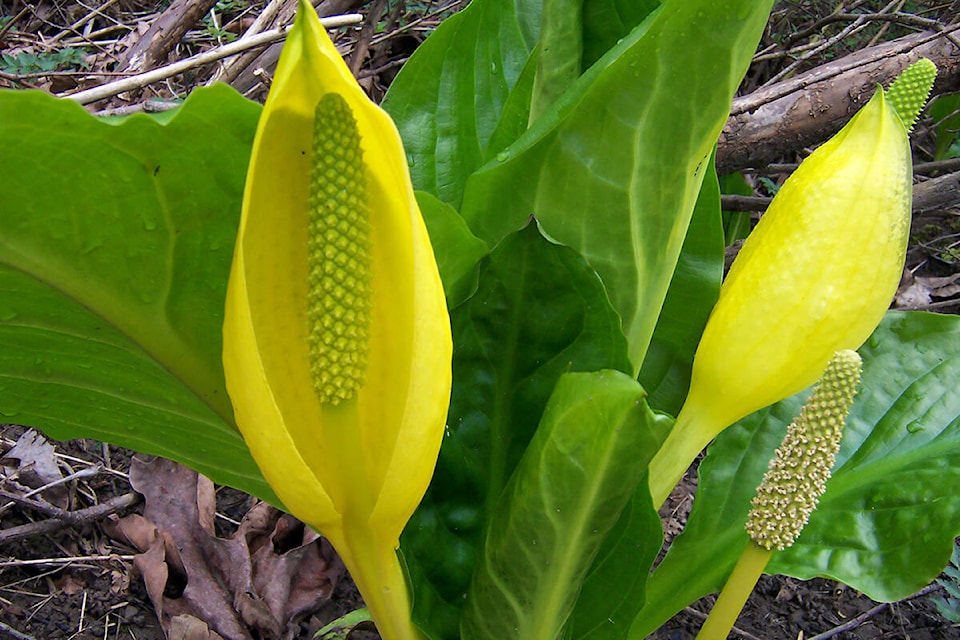By Leslie Cox
Special to The Record
A headline caught my eye in the January 2006 edition of the Royal Horticultural Society’s The Garden. It read, “Scottish lochs fall foul to skunk cabbage.” The article states this “new threat has invaded waterways and wetlands in Scotland” and goes on to say it is “clogging water channels and colonizing wetland ecosystems.”
I had to chuckle because it was a Scot, Captain Walter Grant, who introduced Scotch broom to his acreage near Sooke in 1850. Apparently, he missed the cheerful yellow flowers of this plant from his motherland.
I first wrote about broom, Cytisus scoparius, in a February 2007 column, proclaiming its resilience and incredible ability to survive in our region.
Broom plants can live for 10 years or so, and are capable of producing upwards of 3,500 seeds in a single season. That is a lot of progenies. But if growing conditions are not favourable for germination, the seeds can lie dormant for decades.
Because of broom’s deep taproot, landscapers used this plant to lessen soil erosion on slopes. It is why we see so much broom along our highways.
Going back to skunk cabbage, (Lysichiton americanus), someone… and I could not find any mention of a single culprit… introduced the North American native as an ornamental plant into the UK in 1901. It was very popular even after several had escaped into the wild in 1947.
An article published in 2018 on a Scottish invasive species website claimed skunk cabbage had almost completely taken over a hectare of marsh at the head of West Loch Tarbet in Argyll. It also proclaimed skunk cabbage was still being sold in nurseries in 2009. And likely is available, even now.
Skunk cabbage can be detrimental to native species because it emerges from the ground so early in the growing season. In fact, fresh leaf buds are often visible before all the frost is gone.
This is because of skunk cabbage’s ability to generate heat… called thermogenesis… which melts any surrounding snow and frost, as well as attracts early pollinators once the flower bud opens. It gives the skunk cabbage a substantial headstart on many other plants in its vicinity and hence, the opportunity to overwhelm them.
If we think Scotch broom is hard to get rid of, skunk cabbage reproduces not only by seed but also by its spreading rhizomes. One author also claims this plant can live for up to 80 years, as unbelievable as it sounds. Who knows? But its removal is mostly done as it is here for Scotch broom - manually by dedicated volunteers. Kudos to all volunteers everywhere!
Flipping through the magazine another headline caught my eye: “Wild Wollemi pines under attack.” Almost made my heart stop.
For anyone who does not know about this pine species, Wollemi nobilis, it is a rare evergreen conifer and the only species in its genus. Once thought to be extinct, 100 trees were discovered in a deep, remote Australian canyon in 1994. Because these trees were so rare, their exact location was kept a closely guarded secret.
Unfortunately, the location of the hidden Wollemi pines was found and sadly, scientists have discovered one of the pines has become infected with a soil-borne pathogen which causes root rot. These ancient trees are under threat of being wiped out but are currently being treated with a fungicide in the hopes they can be saved.
I guess the moral here is all gardeners need to respect any “dark side” of a plant acquisition just as much as its beauty. But I do not know how we can stop spreading harmful pathogens on the soles of our hiking boots. That one is a problem.
Leslie Cox co-owns Growing Concern Cottage Garden in Black Creek. Her website is at www.duchessofdirt.ca
